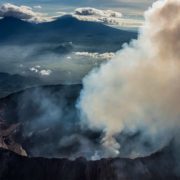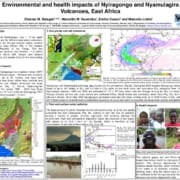INFLUENCE OF MOISTURE SOURCE DYNAMICS AND WEATHER PATTERNS IN CENTRAL-EASTERN AFRICA
Charles M. Balagizi a, ⁎ , Marcelino M. Kasereka a , Emilio Cuoco b , Marcello Liotta c
Abstract: We report the first δ 18 O and δ 2 H rainfall data from Virunga in the Eastern Democratic Republic of Congo, located at the boundary between Central and East Africa. The dataset is from 13 rain gauges deployed in and around Mount Nyiragongo sampled monthly between December 2013 and October 2015. The δ 18 O and δ 2 H vary from -6.44 to 6.16 ‰ and -32.53 to 58.89 ‰ respectively, and allowed us to define a LMWL of δ 2 H = 7.60δ 18O + 16.18. Three main wind directions, i.e. NE, E and SE, were identified in the upper atmosphere corresponding to three main moisture source regions. In contrast, the lower atmospheric winds are weaker in nature and originate mainly from the S and SW, creating a more local, topographically driven moisture regime. The latter is due to the accumulation on the ground of the Lake Kivu water vapour rift forming an isotopically enriched vapour layer that mediates the isotopic enrichment of falling raindrops. Strong seasonality is observed in the δ 18 O and δ 2 H data, and is mainly due to the combined seasonal and spatial variation in moisture sources. The δ 18 O and δ 2 H seasonality is therefore correlated with weather patterns, as the latter control the shift from wet to dry season, and vice versa. The key feature of seasonality is the variation in monthly precipitation amounts, as the mean monthly air temperature is almost constant on an annual scale. Two hydrological processes of regional importance contribute to the isotope signature: namely, the uptake of moisture from isotope-enriched surface water from East African lakes and from depleted soil-water and plants. Consequently, the proportion of water vapour from each of these reservoirs in the atmosphere drives the enrichment or depletion of δ 2 H and δ 18.O in precipitation. Thus, during wet periods, vapour from soil and plant evapotranspiration dominates producing isotopically depleted precipitation, as opposed to dry periods when vapour from lake surface evaporation dominates, producing isotopically enriched precipitation. On a global scale, our dataset narrows the gaps in this region that has been poorly studied for δ 18 O and δ 2 H in precipitation. At the regional scale, better understanding of the ways in which land cover, seasonal and spatial moisture source dynamics and atmospheric patterns impact spatial and temporal variabilities in precipitation in East-Central Africa will contribute to ongoing research on mitigating the impacts of ongoing climate change in Sub-Saharan Africa. Reducing gaps and uncertainties in δ2 H and δ 18 O precipitation, and understanding their interrelationship with climate patterns are essential for better past, present and future environmental and climate modelling at local and regional scales.
Keywords: Virunga precipitation stable isotopes. Moisture source for Virunga. Precipitation variability of Virunga. Stable isotopes of East African lakes. Virunga Local Meteorological
a Departamento de Geoquímica y Medio Ambiente, Observatorio Volcán Goma, 142, Av. du Rond-point, Goma, República Democrática del Congo
b Università della Campania “Luigi Vanvitelli”, Via Vivaldi 43, 81100 Caserta, Italia
c Istituto Nazionale di Geofisica e Vulcanologia, Sezione di Palermo, Via Ugo La Malfa, 153, 90146 Palermo, Italia











